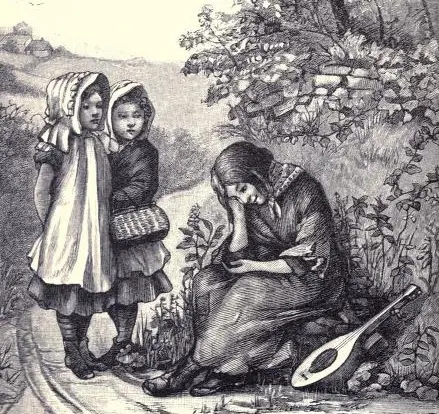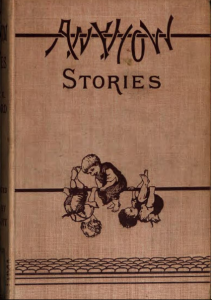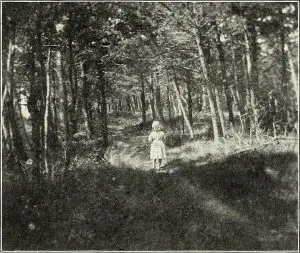
AS I flip through the scrapbook of my older daughter’s first year, there is much I don’t recognize. The pink-and-black polka-dotted dress with the poodle appliqué. The moon-and-stars pattern on her convertible car seat. The babies propped up in a line at her birthday party. The settings follow the seasons—a pile of orange leaves, Santa’s lap, a wading pool—all unfamiliar to me. Often my daughter poses alone, the shots taken from various angles, every possible expression captured.
I gravitate toward images of her gazing off into the distance, perhaps searching for me, I think, but of course she is not. She doesn’t know me yet. She doesn’t even know the possibility of me. If anything, her look reveals she suspects something is missing but can’t put her finger on what. In a child, that look is devastating. I imagine my arms squeezing her as she eyes shorn sheep at a fair, my hands supporting her as she tries to focus and smile, my fingers cradling her head, stroking her cheek. I substitute myself into the frames, grateful this document exists. Then I slam the book shut as I always do.
My daughter’s scrapbook, known as a Life Book, records her life before she met me, a life chronicled lovingly by those who first cared for her if the detail put into arranging each page—the ribbons and themed backgrounds and buttons and printed first-person accounts of jumping in her Exersaucer, learning to walk, trick-or-treating—is any indication. I resist the temptation to harden myself. I wasn’t there. Whatever happened doesn’t concern me. Yet, it does, of course it does. She is my daughter, she has been since she was two-and-a-half. Everything that came before came with her the day she entered our lives.
*
WE learned our daughters’ names on a Friday in September, seven weeks after we were approved to adopt. We’d hunkered down for a long wait, had booked trips, bought a convertible. That night we were going to an out-of-town wedding.
“They’re siblings,” the social worker said. “The older one is two-and-a-half. The baby is fourteen months.” They were being cared for by different foster families, had never lived together. We would meet the girls in their respective homes within a week. Needless to say, we went to the wrong wedding. It took us over an hour to notice we didn’t recognize anyone.
As soon as we got photos, I searched for connections, clues to their lives. The towel draped on the chair beside the Peg Perego stroller. The squinting forehead crease. The chubby little noses. The deep-set, almond eyes. The curls. Who were these children? In what ways were we alike?
We called up our families and friends and got to work painting, laying a bamboo floor, hanging curtains, cleaning. I put Guns N’ Roses’ “Sweet Child O’ Mine” on repeat, playing it obsessively, sometimes clicking back to the beginning before the song was over. The circus-riff opening. The howling chorus. The gruff, sentimental verses. She’s got a smile that it seems to me/reminds me of childhood memories/Where everything/Was as fresh as the bright blue sky. I was swooning.
It was raining the day we met our daughters. We got lost that day, too. We would meet the baby first. In the days to come, however, we’d have more visits with our older daughter who, because of her age, would take longer to shift her attachment to us. As we settled onto the couch at the first foster home, our preverbal younger daughter climbed into my lap and lay her head on my chest, claiming me. Our older daughter didn’t have such an easy time. She was watching out her window when we pulled up.
“You’re getting a new mommy,” her foster mother had told her a few nights before. In fact, that’s what she called me, New Mommy. She called my partner The Man. She, too, sought ways to connect, zeroing in on our shared curly brown hair, but she remained wary.
I visited our older daughter daily, absorbing her routine, feeding, bathing, dressing and playing with her. Always she was watching at the window for me when I arrived. I performed each maternal task, first alongside her foster mother, then alone, to earn her trust. Her foster mother took pictures, and we built a new album, filled with images of me inserted into the only home she had known. Attachment takes time, I’d learned. I’d also learned that attachment comes from receiving comfort during experiences of distress or pain. But what if I, or what I represented, was a source of her pain?
Bedtime proved the hardest routine to transfer. Some nights, she permitted me to sit beside her on the couch as her foster mother read a book of nursery rhymes. Other times I had to content myself on a chair across the room. She might allow me to hold her hand as she dozed off in her crib. But when I picked up the nursery-rhyme book, she rebuffed me with a wail, unwilling to let me take over her story.
Imagine it this way: after a seven-week pregnancy, you’ve given birth to mobile twins at different developmental stages.
Imagine this, too: these twins have trauma.
And this: you have trauma, too.
*
WITHIN days, our older daughter was calling us Mama and Daddy and using her foster parents’ first names. I took to referring to myself in the third person, as in “Mama would like you to put on your socks!” a habit I fall back on to this day, though she is nine.
We soon found out she liked to run. Without warning, she would race across a park, down an aisle, or along a busy street. No amount of cajoling or scolding would stop her. She demanded the chase and the catch. Her sister followed suit, often in the opposite direction. I had to devise systems in order to leave the house without help.
The wildness didn’t stop at home: toys dismantled, walls defaced; pages ripped from books. As a bedtime routine, I set up cushions in our attic loft, a room lined with bookshelves. Neither of our daughters was ready to snuggle with me for a story.
Picture it: A mother sitting on the floor reading Goodnight Moon while a pair of toddlers tear around the room, yanking books off shelves, tossing them in the air, skidding on pillows. One night, frustrated, I raise my voice, “Mama’s an author, and she doesn’t appreciate how you’re treating books!” My daughters had lived in kind, well-structured foster homes with devoted caregivers, but they hadn’t lived together. And they had never lived with me.
I was their third mother.
I was New Mommy, and I was playing for keeps.
*

by Lucy Clifford
MacMillan & Co., London 1882
IN 1882, Lucy Lane Clifford published Anyhow Stories Moral and Otherwise. One of the stories in the collection, “The New Mother,” tells the unsettling, if not horrific, cautionary story of two sisters (named “Blue Eyes” and “Turkey” after the author’s own daughters) enticed into “naughty” behaviour by a strange girl lingering after a village fair. Despite their mother’s threats to leave them if they misbehave, the sisters tear apart her lovingly kept cottage. To their surprise, she does leave. When a new mother, with flashing eyes and wooden tail, shows up to replace her, the children flee to the forest.
“If you loved me, you couldn’t make me unhappy,” the mother in “The New Mother” says to her children. When she warns them of her successor, the children respond with “We should hate a new mother; and she shall never come here.” Meanwhile in town, where dancing dogs linger after the travelling fair, the stranger’s wares tempt the girls. Though Turkey and Blue Eyes have arrived too late for the carnival, here the curious girl sits, advising them that they can only hear her peardrum if they do mischief.
Read: they can only have the thing they want if they rebel.
The children promise to misbehave and set out to do exactly that when they get home, breaking mugs, tossing food, throwing water on the fire, wrenching items off the wall, smashing the clock. Longing to take part in the subversive world of the carnival they’ve missed, the children create chaos out of the intimate space nurtured by their mother. Their desire to disobey their mother so they can hear the peculiar girl’s peardrum and see a little man and woman dance is mitigated by their disbelief that their mother would ever leave. And then, terribly, she does.
*
FAMILY members accused us of holding our children too close, called us “helicopter parents.” It’s true, we were vigilant. We did not pass our children from lap to lap. In fact, we waited a full six months after placement before bringing them to a family gathering, an Easter dinner. In the photos, taken in a suburban backyard, our younger daughter, wearing a pink dress coat and ribbon headband, rarely leaves my arms. In a tutu and glittery pink runners, our older daughter plays on a swing, her head turned, eyes searching, worried. In this moment, I am certain, she wants us, her parents.
When an aunt initiated playing Rock-a-Bye Baby, embracing and nuzzling my older daughter, my insides seized up, and my partner swooped in to break up the game. Even this natural moment with extended family, one I might have performed with my niece, threatened my status. Every interaction needed to delineate that I was the mother or, we feared, the attachment process would fall apart.
As we were not our daughters’ first set of parents, the social worker had cautioned us to expect them to test us. How we responded would go a long way to securing their attachment and helping them succeed in having healthy relationships throughout their lives. The more comfortable they got, the more testing we could expect. In other words, “bad behaviour” was a good sign.
Our older daughter has an earthy, empathetic relationship to the world. Some of her most heartfelt emotions emerged while interacting with our aging Newfoundland dog. When he struggled to mount stairs, she’d burst into tears. After he died, she talked about him daily and for years referred to missing him as an explanation for sadness, equating that particular, tangible grief with a greater, as yet unnamable loss. She threw epic tantrums (though these are not specific to adopted children), impulsively biting, pinching, head-butting, punching and kicking us. She has hurled furniture, slammed doors in our faces. She pushes and pushes us, her anger understandable, her loss unfathomable. Yet, we remain constant. We stay put and do our best not to react, though we do, of course we do, our own issues from childhood aroused by her pain.
We reassure our children that they did not cause their placement in foster care. We tell them they are good, that all children are good. In our house, Santa Claus’ gifts are not contingent on children’s “nice” behaviour. In our house, the Elf on the Shelf stays year-round, encased in a gym sock so we can touch him with impunity. Yet in moments of distress, our older daughter revisits her primal loss keenly. Despite our devotion, she assumes the script that she has done something wrong.
*
A few months after our daughters came home, I bought a ticket to a Guns N’ Roses concert. I had recently carved out a daily morning hour to write at a local diner and was making a habit of listening to the band’s latest album, its first in decades. Axl Rose’s voice rang out as intensely as ever on these new songs, twinning rage and loss.
Rock concerts are spectacles. The best I’ve attended have been boisterous and transcendent, a nexus of emotional connection and release through the raw expression of electric guitars, drums, and seething vocals. I was at home with a baby and a toddler when I bought the ticket, isolated by choice from my previous life. I was desperate for commiseration, but most adoption books and blogs dealt with children placed at birth or adopted internationally. Few addressed our situation, a closed domestic adoption of two children living together for the first time.
Though I’d seized the yearned-for chance to be a mother, the sudden intensity of adopting made me feel like a trauma survivor. I read slights into the actions of friends I’d known for decades. I lost weight. My older daughter’s behaviours drove me to hide in the bathroom, screaming into a towel. I compared myself unfavourably to the foster mothers. I embarked on and abandoned several scrapbooks of my own.
Out in the world—at parks, libraries, Early Years Centres—people asked what it was like having babies so close together. Caught by surprise, I’d blurt out our situation. “You’re an Angel,” they’d respond. “There’s a special place in Heaven for you.” When they weren’t praising me, people pressed for private information about the girls’ circumstances. I had wanted my children with all my heart and was beyond grateful to have them in my life. I just hadn’t expected the disconnect between the promise and the reality of motherhood. My anger surprised me. For an adoptive mother there is no accepted narrative for this feeling. There are no hormones to blame. There is only endurance. Or release.
The night of the concert, I started drinking as soon as my children fell asleep. At the stadium, I whipped out a flask, which a security guard relieved me of soon after. From the first chords of “Chinese Democracy” to the encore pyrotechnics of “Paradise City,” I was on my feet screaming with relief.
The concert liberated the anger I’d felt at finding myself in a wilderness of my own design. But my anger also needed soothing and perspective. It required empathy—acknowledgement of the pain sitting there breathing inside all the love.
In The Faraway Nearby, Rebecca Solnit speaks of empathy as “a kind of music” whose sound we catch, evoking Wordsworth’s phrase, “the “still sad music of humanity.” Among the possessions our daughters brought when they came to us were CDs they’d listened to at bedtime. Our older daughter loved “Hush Little Baby,” insisting we play it over and over. We often woke up to her singing voice drifting from the baby monitor. Motherhood asked me to enter that music with her, to stand outside myself and feel with her what I did not feel myself.
After the dreamy verses and chorus, “Sweet Child O’ Mine” takes a turn into starker territory. Rose repeats, Where do we go now?, layering his voice, then unleashing his trademark penetrating yowl described variously as “death metal she-wolf,” “air-raid siren,” and “Devil Woman.” This coda inhabits a space of anguish and searching, for love, for a home that, like the children’s home in “The New Mother,” remains ever out of reach. Rose’s voice resonates as a cry of furious grief, the shrieks of an inchoate child expressed in adult form.
Likewise, “The New Mother” conveys the loss at the heart of adoption: “They did not really believe that their own mother would not come back, or that any new mother would take her place.” And when the new mother does come, in all her sinister glory, with her flashing glass eyes and wooden tail, the children flee to the woods. They do not engage with her because she is too bizarre and frightening.
Though our daughters have experienced a through-line of love—from birth parents to foster parents to us, they’ve had no shortage of love—their care has transferred hands. Once, I was as unfamiliar as the monster. Now, like the mother in the story, I can create the coziest, most welcoming home for my daughters. I can enfold them in infinite hugs and kisses and myriad reassurances of my devotion. Nevertheless, as I am not the first, I worry that like Turkey and Blue Eyes, to some degree, my children will forever be in the forest out of my reach.
Notably, however, it is with the imaginary creature that I share a singular, most important trait: I am staying put. And unlike the children in the story, my daughters have found the courage to come safely home.

—A CNQ Web Exclusive, June 2016
